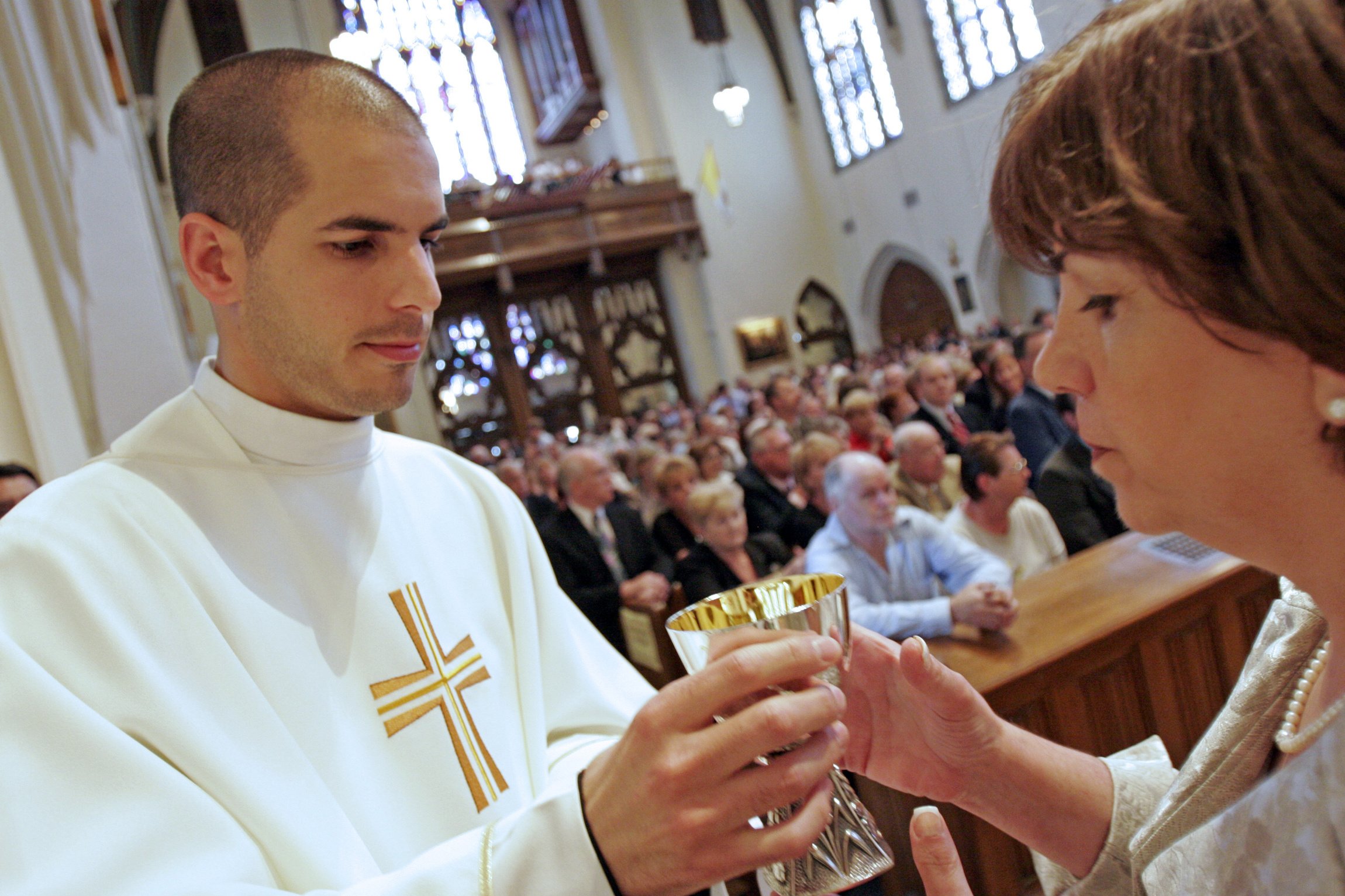Cardinal Tobin: Churches can return to the Communion Cup, fill fonts with holy water
The Archdiocese of Newark is lifting the pandemic moratorium on Communion from the Chalice so that parishioners can go back to fully experiencing the Eucharist.
Parishes can begin offering the Blood of Christ at Mass as early as Holy Thursday, April 6, but no later than Pentecost Sunday, May 28. Additionally, holy water will again be allowed in the fonts.
The directives were issued this week by the Worship Office of the Archdiocese of Newark and approved by Cardinal Joseph W. Tobin, C.Ss.R., Archbishop of Newark, allowing all parishioners in Bergen, Essex, Hudson, and Union counties to “respond to Jesus’ command to eat and drink at their own level of comfort.”
After being closed in March 2020 due to the pandemic, Catholic Churches within the Archdiocese of Newark reopened in June 2020 for Mass and communion but with the distribution of the consecrated host only.
Due to concerns over sharing the chalice during the pandemic, the Archdiocese of Newark, like many others, placed a moratorium on its distribution following the U.S. Conference of Catholic Bishops April 2020 recommendation that the “precious Blood should not be distributed to the faithful, nor should the faithful receive the Eucharist by intinction.” Communion from the Chalice was reserved for the clergy who are obligated to receive the Blood of Christ at every Mass, according to the directive.
In the Gospel of Matthew, at the Last Supper, Jesus specifically commanded his disciples to “eat” and “drink” his Body and Blood. This command is at the heart of Catholic worship – the Liturgy of the Eucharist. Jesus gave his Body and Blood to be consumed. In the Gospel of John, Jesus taught: “Unless you eat the flesh of the Son of Man and drink his blood, you do not have life within you.”
While protestants believe communion serves to commemorate Jesus’ death and resurrection, Catholics believe in “transubstantiation” — that when the priest consecrates the bread and the wine on the altar, the meal becomes the Body and Blood of Christ.
“Although it is not required, taking from the cup is considered a fuller participation in the Eucharist and a direct response to Jesus’ command to take and drink,” said Father Tom Dente, director of the Archdiocese’s Office of Worship.
The directive also advises parishioners wishing to receive Holy Communion from the chalice: “They should approach the minister and bow their head slightly in a sign of reverence. When the minister says ‘The Blood of Christ,’ the communicant replies audibly, ‘Amen,’ takes the chalice from the minister and drinks. The minister then takes it back and firmly wipes both sides of the rim while turning it slightly for the next communicant.”
Most parishes in the northeast procure the sacramental wine — naturally fermented with nothing added to it — from O-Neh-Da Vineyard, located in Conesus, N.Y., and the oldest authentic producer of premium sacramental wine in the U.S. Founded in 1872 by Bishop Bernard McQuaid, O-Neh-Da Vineyard was established to produce authentic sacramental wine for local churches.
Full recovery of the Mass
During the pandemic, many liturgical ministries of the church were minimized or eliminated. Altar servers were replaced by book stands; lay readers were replaced by clergy; musical elements were reduced or eliminated.
In post-pandemic times, the Archdiocese is now calling on parishes to revitalize their worship; inviting back ministers who stepped down during the pandemic, and installing additional ones where needed.
“With properly prepared ministers assisting at worship, the faithful are better able to encounter Christ in the Assembly, the Word, and the Eucharist,” the directive states. “The Church cannot afford to minimize its experience of prayer when so many need the presence of Christ in their lives. With the full use of clerical and lay ministries, worship will come alive again.”
Parishes were forced to reduce the amount of singing or even eliminate it during the height of the pandemic and many churches have not returned to pre-pandemic times when it comes to music.
“Music in the liturgy fulfills many purposes,” the directive reads. “It often accompanies liturgical action like the opening song of Mass which is sung during the entrance procession or the Lamb of God which accompanies the breaking of the bread. Music itself can be a prayer as in the singing of the Gloria or the Holy, Holy, Holy. Liturgical music shapes the liturgy and the seasons of the church year. It can voice hope at a funeral and joy on Easter morning.”
The Archdiocese is also calling for the return to music as an important part of the Mass and the key to full participation: “Every care should be taken that singing by the ministers and the people is not absent in celebrations that occur on Sundays and Holy Days of obligation.”
And finally, beginning at the Easter Vigil, holy water must be returned to all baptismal fonts and holy water receptacles.
Featured Image: Archdiocese of Newark churches can return to Communion by the Cup as soon as April 8. In this photo from 2008, a priest offers the Communion cup to a woman during a Mass at St. Agnes Cathedral in Rockville Centre, N.Y. (CNS photo/Gregory A. Shemitz, Long Island Catholic)



